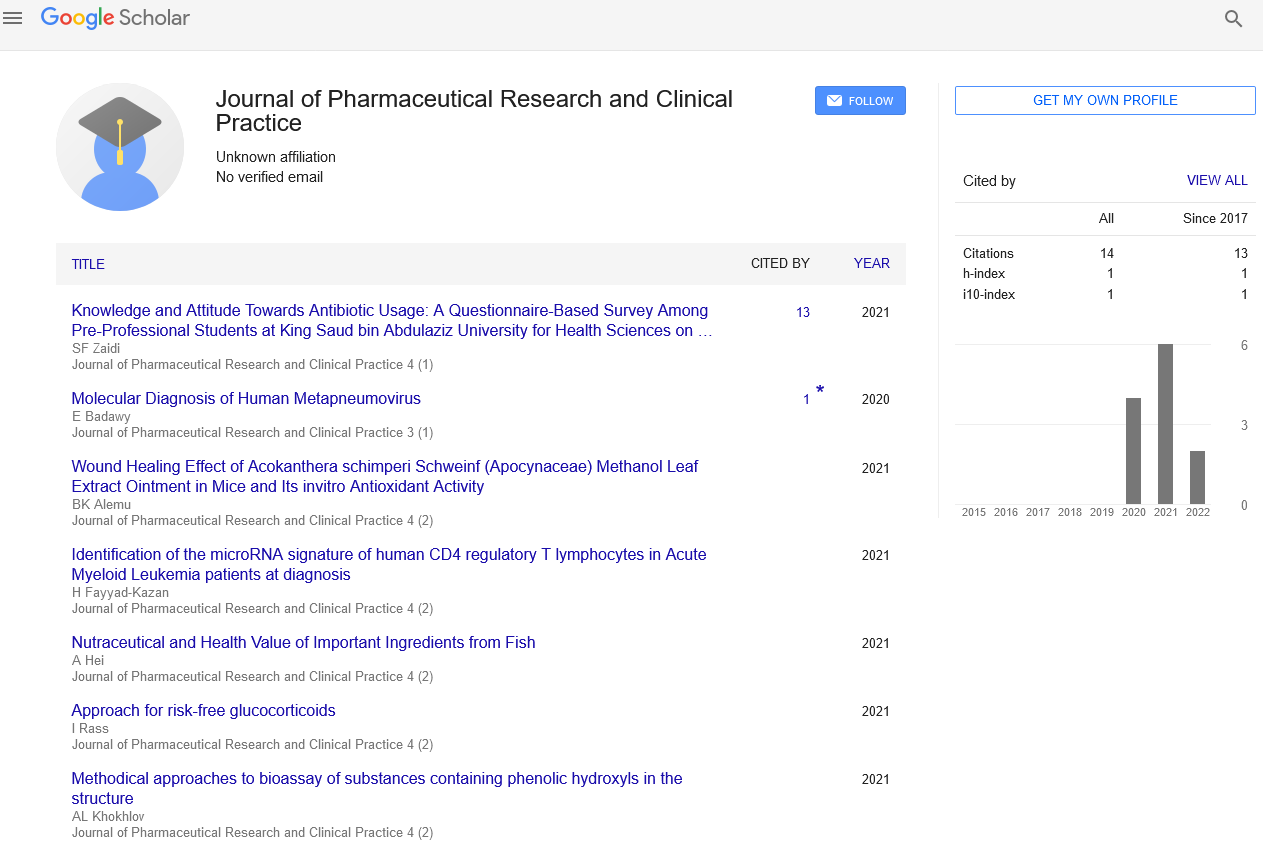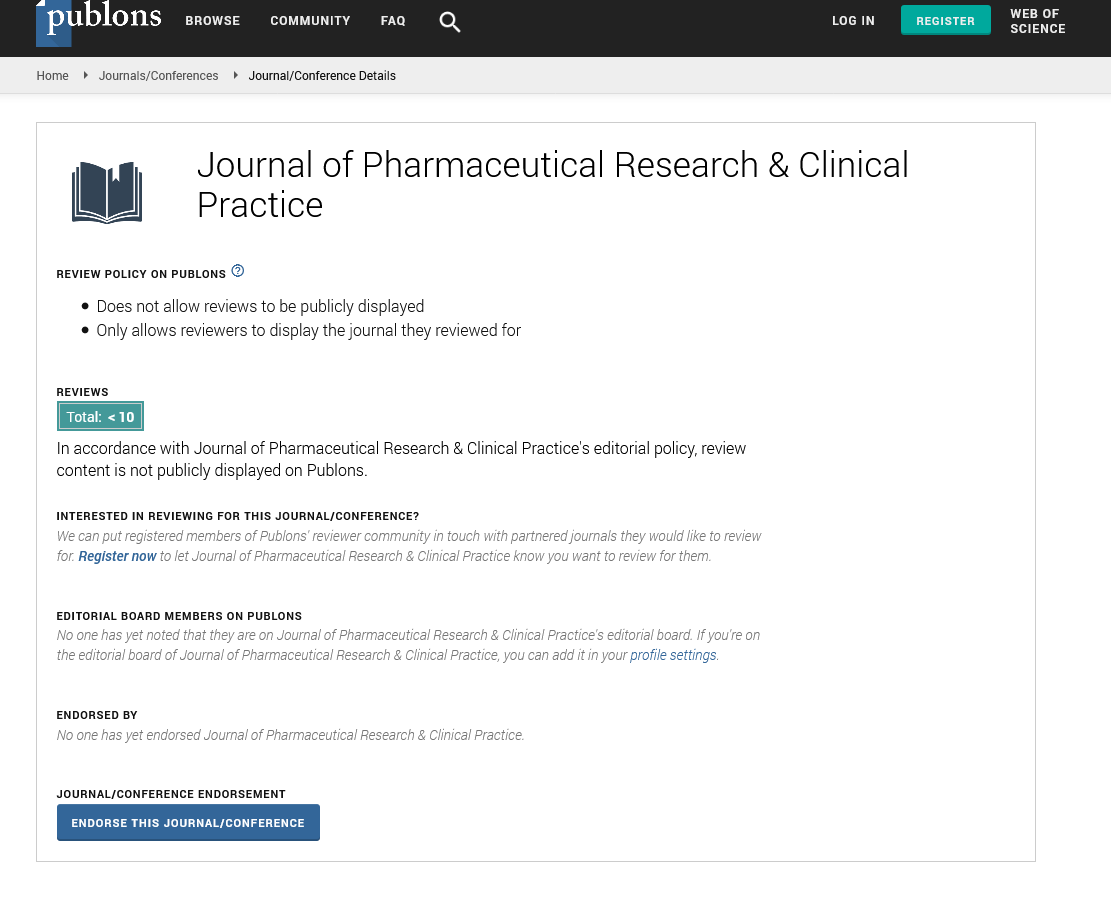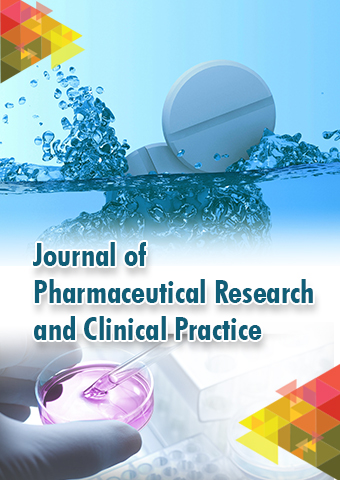Commentary - Journal of Pharmaceutical Research and Clinical Practice (2022) Volume 5, Issue 3
Recovery of Infarcted Myocardium in an In Vitro Experiment
Virginija Bukelskiene*
Bukelskiene, Institute of Biochemistry, Vilnius University, Mokslininkų 12, 08662 Vilnius, Lithuania.
Received: 02-Jun-2022, Manuscript No. jprcp-22-42152; Editor assigned: 06-Jun-2022, PreQC No. jprcp-22-42152 (PQ); Reviewed: 20- Jun-2022, QC No. jprcp-22-42152; Revised: 23-Jun -2022, Manuscript No. jprcp-22-42152 (R); Published: 30-Jun-2022, DOI: 10.37532/ jprcp.2022.5(3).56-58
Abstract
Acute myocardial infarction leads to the loss of functional cardio myocytes and structural integrity. The adult heart cannot repair the damaged tissue due to inability of mature cardiomyocytes to divide and lack of stem cells. The aim of this study was to evaluate the efficiency of introduced autologous skeletal muscle derived stem cells to recover the function of acutely infarcted rabbit heart in the early postoperative period. As a model for myocardium restoration in vivo, experimental rabbit heart infarct was used. Auto logic adult myogenic stem cells were isolated from skeletal muscle and propagated in culture. Before transplantation, the cells were labeled with 4,6-diamidino-2-phenylindole and then, during heart surgery, introduced into the rabbit acutely infarcted myocardium. Postoperative cardiac function was monitored by recording electrocardiograms and echocardiograms. At the end of the experiment, the efficiency of cell integration was evaluated histologically. Rabbit cardiac function recovered after 1 month after the induction of experimental infarction both in the control and experimental groups. Therefore, the first month after the infarction was the most significant for the assessment of cell transplantation efficacy. Transplanted cell integration into infarcted myocardium was time- and individual-dependent Evaluation of changes in left ventricular ejection fraction after the induction of myocardial infarction revealed better recovery in the experimental group; however, the difference among animals in the experimental and control groups varied and was not significant.
Keywords
myocardial infarction• stem cell• laboratory animal
Introduction
Cardiovascular diseases present the major and growing public health concern due to the aging of the world’s population. According to the World Health Organization, the morbidity due to this reason is estimated to reach a pandemic level by 2020. Myocardial infarction (MI) caused by coronary artery disease is one of the major causes of heart failure (HF). Despite optimal medical therapy and aggressive revascularization strategies, MI with left ventricular dysfunction is a lethal condition for 25% of patients during 3 years after the event. Currently used therapeutic measures are not sufficient to prevent left ventricular re modeling and subsequent development of HF. Patients with New York Heart Association (NYHA) class IV heart failure are treated by pharmacotherapy or sometimes by heart transplantation [1]. Heart transplantation remains the treatment modality with the best outcome showing the 5-year survival rates of around 65%. However, it is limited by the current shortage of donor organs and the complications of long-term immunosuppression. Due to the above limitations, cell transplantation is an area of growing interest in clinical cardiology as a potential method of treating the patients with MI and/or HF. The goal of cell therapy is a replacement of a kinetic scar tissue with viable myocardium aiming to improve the cardiac function along with inhibition of the re modeling process. This novel technique of treatment has been intensively researched in the last few decades; however, it has not been widely introduced into clinical practice yet. The majority of cardio myocytes are known not to re-enter the cell cycle after their treatment with various agents [2].
Material and Methods
For this experimental study, California rabbits weighing 3.0–3.5 kg were used (Vivarium of the Institute of Biochemistry, Vilnius University). All animal surgical procedures were performed under general anesthesia. The animals received humane care according to the “Law on the Care, Welfare and Use of Animals” of the Republic of Lithuania. License for the use of laboratory animals in stem cell research (No. 0171, 31-10-2007) was obtained from the Lithuanian Food and Veterinary Office. In this study, 13 animals were used: 6 in the control group and 7 in the experimental group [2]. Preparation of Autologous Skeletal Muscle Stem Cells Under general anesthesia of the animal a longitudinal incision was made intramuscularly over the projection of the biceps femoris muscle, and a 0.5- cm3 piece of muscle tissue was removed and placed into the transportation medium (Dulbecco’s modified Eagle’s medium, DMEM, Sigma-Aldrich) with penicillin (100 U/ mL) and streptomycin (100 mg/mL; both from Biological Industries, Israel). Subsequently, the tissue was minced and treated with a mixture of enzymes – 0.125% trypsin-EDTA (Sigma) and 1 mg/mL collagenase type V (Sigma) – prepared in phosphate buffered saline (PBS) as described by Širmenis [3].
Discussion
Up to now, numerous clinical or animal studies conducted to evaluate a particular class of cells for its regenerative potential in the infarcted heart have demonstrated an improvement in cardiac function of various degree. Various cell types including cardiomyocytes, skeletal myoblasts, mesenchymal stem cells, bone marrow-derived mononuclear cells, etc. were used in preclinical or clinical trials and showed their own advantages and limitations in cardiomyoplasty. Distinct mechanisms have been proposed for different cell types in improving the cardiac function. Rabbit skeletal myogenic cells used in our experiments to restore damaged rabbit tissue after induction of myocardial infarction were described in our previous papers. The present study was focused on the grafted cell integration into myocardium and subsequent postoperative functional cardiac recovery within the fi 1st month [4]. Analysis of the results obtained from animals in the control group revealed that damaged rabbit myocardium maintains the ability of self-repair within the period of one month after injury. Therefore, the data obtained on our experimental rabbit model indicate that a period of up to one month is critical for the assessment of stem cell therapy effectiveness in the improvement of heart function. Evaluation of the role of transplanted cells in the restoration of cardiac functions during later periods is problematic.
Conclusions
The transplanted autologous skeletal muscle derived myogenic cells were proved to be able to survive in the acute infarction site; however, the level of cell integration varied. These differences in integration may account for the differences in cardiac function recovery. Establishment of strategies applying physical, biochemical, and genetic methods aimed at an improvement in stem cell integration and survival in damaged tissues is currently underway.
Results
Our previous long-term research when rabbits were investigated during a 3-month period showed that the rabbit cardiac function in the control group generally recovered within a month after experimental myocardial infarction. Consequently, in this study, to evaluate the effect of grafted cells on the rabbit heart function, special attention was given to the fi 1st month after cell transplantation. During this period, the results of histological examination and echocardiographic cardiac function assessment were analyzed and compared in order to understand the early processes undergoing in the infarction area. Functional myocardial infarction and postoperative period was observed and evaluated during ECG. Left ventricular ejection fraction was mostly restored in the period of 28 days after myocardial infarction induction; the infarction zone contractility improved, although with a few exceptions, it remained hypo echogenic. Most attention was given on the processes in the infarcted area. Despite the fact that the changes in left ventricular ejection fraction after the induction of myocardial infarction varied both in the experimental and control groups, the data revealed better recovery in some test animals with grafted stem cells [5]. Although the difference among animals in the experimental and control groups varied and was not statistically significant, a trend toward a slight improvement was observed in the experimental group. In particular, it was most clear at the end of the month, when left ventricular ejection fraction reached the baseline level more quickly.
Acknowledgement
None
Conflict of Interest
No conflict of interest
References
- Taylor DO, Edwards LB, Boucek MM, Trulock EP, Waltz DA, Keck BM, et al. Registry of the International Society for Heart and Lung Transplantation: twenty-third official adult heart transplantation report. J Heart Lung Transplant, 25:869-871(2006).
- Hassink RJ, Pasumarthi KB, Nakajima H, Rubart M, Soonpaa MH, de la Rivière AB, et al. Cardiomyocyte cell cycle activation improves cardiac function after myocardial infarction. Cardiovasc Res,78:18-25(2008).
- Cheng RK, Asai T, Tang H, Dashoush NH, Kara RJ, Costa KD, et al. Cyclin A2 induces cardiac regeneration after myocardial infarction and prevents heart failure. Circ Res,100:1741-1748(2007).
- Watanabe E, Smith DM Jr, Delcarpio JB, Sun J, Smart FW, Van Meter CH Jr, et al. Cardiomyocyte transplantation in a porcine myocardial infarction model. Cell Transplant, 7:239-246(1998).
- Min JY, Yang Y, Sullivan MF, Ke Q, Converso KL, Chen Y, et al. Long-term improvement of cardiac function in rats after infarction by transplantation of embryonic stem cells. J Thorac Cardiovas Surg,125:361-369(2003).
Indexed at, Google Scholar, Crossref
Indexed at, Google Scholar, Crossref
Indexed at, Google Scholar, Crossref
Indexed at, Google Scholar, Crossref


